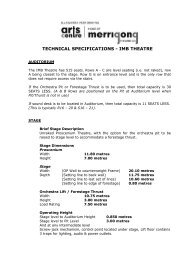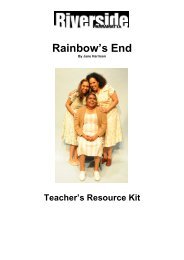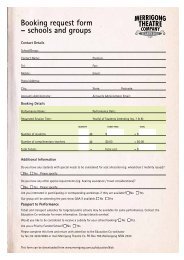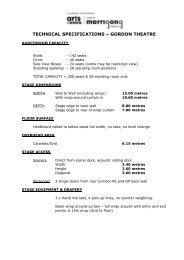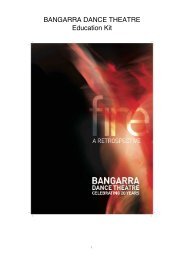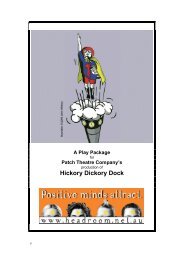UNTRAINED
UNTRAINED - Merrigong Theatre Company
UNTRAINED - Merrigong Theatre Company
- No tags were found...
Create successful ePaper yourself
Turn your PDF publications into a flip-book with our unique Google optimized e-Paper software.
Classroom Management Suggestions<br />
Dance/Movement and Drama can be used to enhance classroom-based learning by providing<br />
opportunities to explore ideas and issues in different, expressive ways. Engagement in the creative<br />
arts, including dance/movement and drama, has been considered to assist with the development of<br />
self-esteem, communication skills, problem-solving abilities, and in the development of focus and<br />
team building through fun activities.<br />
Incorporating dance/movement or drama in school classrooms presents a number of challenges for<br />
teachers, but when attempted reaps many rewards for all involved. The following suggestions are<br />
designed to provide some food for thought in relation to working in these areas and are intended as<br />
a guideline only.<br />
When doing dance/movement or drama in the classroom:<br />
- ensure a clear work space is available for the activity (with mats laid if possible). If desks can<br />
not be moved in the classroom, try to use the hall or outside open area.<br />
- talk to the students about the creation of a ‘safe space’. In this space students don’t laugh at<br />
each other, but support and encourage (forming a circle at the beginning and end of a session or<br />
sitting with eyes closed are simple ways to focus students for a session)<br />
- always begin every session with a warm-up. This should include a physical warm-up, but it is<br />
also helpful to begin with a focus/team building activity. There are good books and websites<br />
available with suggestions of warm-up activities and focus games e.g. http://learnimprov.com/<br />
(then go to warm-ups)<br />
- incorporate a reflection session at the end of every activity. This allows the students to<br />
consider what has been done and take more meaning away from the activity than it just being<br />
fun (which it will be!)<br />
- be firm with the students. If a student does not follow instructions, they should be removed<br />
from the activity. This will allow the other students to see that you as the teacher are assisting in<br />
maintaining the safe space for them to work.<br />
- don’t be afraid to participate in the activities yourself. The students like to see you as the<br />
teacher taking a role in an activity. This can also allow you to help any students through<br />
modelling.<br />
If possible, conduct a ‘risk assessment’ with your class before embarking on any physical work. As<br />
class it would be good to discuss the personal, group, physical, and psychological risks inherent in<br />
the working space. Together, the class could devise the measures that would help to minimize these<br />
risks. This collaboration would help the students to realise that physical work can actually be<br />
dangerous, and encourage them to take responsibility for themselves, the group, and the space<br />
they’re working in.<br />
5




